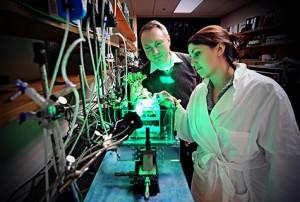Last weekend we saw how doctors were using 3D printing to help them better understand heart issues, which were related to specific patients, prior to them operating. This week we got word of a new application for 3D  printing within the cardiac field of medicine. This time it’s an embeddable device, which promises to change the way doctors monitor, as well as treat many heart conditions.
printing within the cardiac field of medicine. This time it’s an embeddable device, which promises to change the way doctors monitor, as well as treat many heart conditions.
A team of doctors, led by Igor Efimov, PhD, at the School of Engineering & Applied Science at Washington University in St. Louis, have used an inexpensive 3D printer, one like those you would see in the homes of hobbyists, to create a device which may lead to major advances within the predictive cardiac medical field. The team of doctors, biomedical engineers, and material scientists
have printed out 3D membrane made from an elastic silicon material, that is customized to fit the exact shape of the outer membrane of the human heart. They then printed tiny sensors into the material, which will allow them to monitor a variety of important data points within a patient’s heart. This information includes temperature of the heart, ph, and strain. The sensors also have the ability to send out small shocks of electricity in order to fix an arrythmia. The findings of the team were published this morning in Nature Communication.
“Each heart is a different shape, and current devices are one-size-fits-all and don’t at all conform to the geometry of a patient’s heart. With this application, we image the patient’s heart through MRI or CT scan, then computationally extract the image to build a 3D model that we can print on a 3D printer,” said Efimov, the Lucy & Stanley Lopata Distinguished Professor of Biomedical Engineering.
This new 3D printed membrane promises to help doctors treat a variety of cardiac disorders, including diseases in the ventricles in the lower chambers of the heart, as well as artrial fibrillation, and a variety of less common ailments.
 If his isn’t amazing enough, doctors also believe that soon they will be able to fit the membrane with sensors attached, which can measure key levels of a protein, troponin, a chemical present during the early and later stages of a heart attack. Efimov claims that this sort of technology is very similar to the technology Google announced they were working on, earlier this year, which allows for glucose monitoring via a contact lense in the human eye.
If his isn’t amazing enough, doctors also believe that soon they will be able to fit the membrane with sensors attached, which can measure key levels of a protein, troponin, a chemical present during the early and later stages of a heart attack. Efimov claims that this sort of technology is very similar to the technology Google announced they were working on, earlier this year, which allows for glucose monitoring via a contact lense in the human eye.
“This is just the beginning, Previous devices have shown huge promise and have saved millions of lives. Now we can take the next step and tackle some arrhythmia issues that we don’t know how to treat,” said Efimov.
As different verticals in advanced technology merge, including 3D printing, the exponential progress within several health fields should itself become exponential, leading to a rapid development of new life saving technologies across many fields. Discuss this medical discovery at 3DPrintBoard.
Subscribe to Our Email Newsletter
Stay up-to-date on all the latest news from the 3D printing industry and receive information and offers from third party vendors.
You May Also Like
Precision at the Microscale: UK Researchers Advance Medical Devices with BMF’s 3D Printing Tech
University of Nottingham researchers are using Boston Micro Fabrication‘s (BMF) 3D printing technology to develop medical devices that improve compatibility with human tissue. Funded by a UK grant, this project...
3D Printing Webinar and Event Roundup: April 21, 2024
It’s another busy week of webinars and events, starting with Hannover Messe in Germany and continuing with Metalcasting Congress, Chinaplas, TechBlick’s Innovation Festival, and more. Stratasys continues its advanced training...
3D Printing Webinar and Event Roundup: March 17, 2024
It’s another busy week of webinars and events, including SALMED 2024 and AM Forum in Berlin. Stratasys continues its in-person training and is offering two webinars, ASTM is holding a...
3D Printed Micro Antenna is 15% Smaller and 6X Lighter
Horizon Microtechnologies has achieved success in creating a high-frequency D-Band horn antenna through micro 3D printing. However, this achievement did not rely solely on 3D printing; it involved a combination...






























